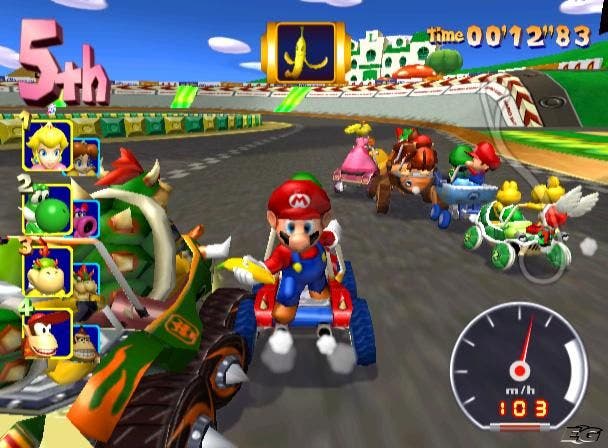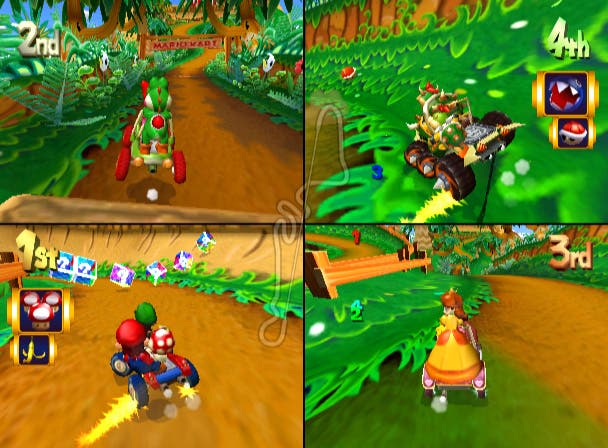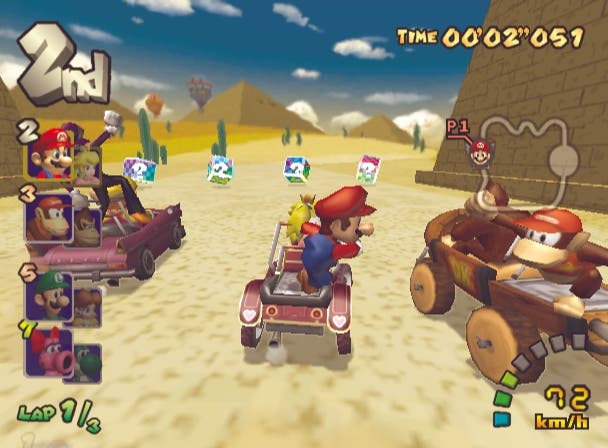ECTS 2003: Mario Kart: Double Dash!!
Belated trade show impressions of Nintendo's racing stalwart. No kids allowed.
If Mario Kart were a PlayStation 2 game, it would be "the talk of the show" for the lack of a better expression. As a focal point of The PlayStation Experience, it would have enjoyed massive queues, big-screen tournaments, neighbouring chill-out areas, sumo wrestling, pop stars, stage acts and even a handy pizzeria. Mama mia!
However, as a GameCube game, it was always doomed to spend this ECTS throbbing away out of the public's eye. But even Nintendo's lorry should have been good for big queues and a bit of media attention - if they had decided to let anybody on it. As it happens, ushers had to turn away plenty of disappointed children on their way towards the Brompton Road tube entrance with their fuming parents, with access limited to 14 year-olds with "Bill Gates, Microsoft" stapled to their teat.
It's not finished...

Then again, we're not about to knock the young chaps with questionable trade badges, because a couple of them helped us derail the Mario bandwagon even further on Friday afternoon. Having been told by show organisers CMP that Mario Kart: Double Dash would be on display in a finished capacity (Nintendo went for "latest version" in its mailout), we were pleased to see single and multiplayer racing modes catering to 1-4 players, Battle Mode making a welcome reappearance, and a game that appeared to be quite finished on the surface.
But on a four-player jaunt over DK Mountain (one of the tracks we caught on its E3 debut), we suddenly realised something was amiss. As yours truly screamed over the swinging rope bridge towards the finish line with a Princess Peach-controlling reprobate in tow, we both lost our way and went soaring into the abyss below. But instead of respawning on the track above, we suddenly landed - on thin air - and found ourselves able to trawl the world from underneath, scooting around with bits of the level above and below and the other chaps looking thoroughly confused.
They weren't the only ones either, because after about 10 seconds of laughter and antics, the GameCube got fed up and locked hard with a frozen picture and a jarringly loud screech that didn't abate until one of Ninty's German troop arrived and clawed off the cabinet's front panels to silence it. He also told our fellow gamers off for taking pictures and threatened to take their camera, barking nasty things into his walkie talkie as he struggled to reboot the game.
Tracking

Arguments about whether the game is finished or not aside (and given that Rogue Leader and other Cube games glitch and lock up from time to time, there's nothing to suggest this isn't considered "finished" anyway), Mario Kart is otherwise looking very trim. Although it's been more than a few months since we last played it at E3, the ECTS code felt a lot faster, and the difference in speed moving across shortcut surfaces (like the angular rock face you can throw yourself across on DK Mountain, or the sandy hill on Mushroom Bridge) is much more pronounced.
In terms of levels, we were limited to the first (presumably Mushroom cup) event, because although the game allows one or two players to partake of Grand Prix mode, if you're playing with three or four then you have to stick with either Single Race or Battle Mode. Of the four tracks we had a chance to play, two of them (Luigi Circuit and DK Mountain) we had already seen at E3 and appeared unchanged, and two of them were new: Mushroom Bridge and Wario Stadium.
Mushroom Bridge we very much like. It has traffic to dodge through tunnels and over the Golden Gate equivalent bridge; it has shortcut jumps; it's an enjoyable route and it's very fast to race because most of the skill is in avoiding obstacles rather than ducking round hairpins. Our only caveat would be that its bogstandard, Mushroom Kingdom visuals are about as daring as the name "Mario Kart".
However Wario Stadium we absolutely adore. Like the N64 versions, it's based on one of those dirt bike arenas, with lots of jumps in varying sizes, tight hairpin turns and, er, spinning columns of fireballs and sabre tooth plants ducking out of giant trackside pipes. Because of the number of jumps and the way some of them leapfrog earlier sections of the track, this is a level where power-ups come to the fore. On more than one occasion during our countless attempts, one of us managed to catch a blue or red shell smack-bang in the middle of a jump and sink dramatically to the track in-between the take-off and landing ramps, forcing us to retrace our steps and no doubt lose placing.
Battle Royale

Having raced our little cotton socks off for quite a time, there wasn't much opportunity to get on terms with the Battle Mode, but we did manage quite a few games before we had to race back to our little web cubicle and report. As it turns out, Nintendo is offering an alternative to traditional balloon-popping in the shape of a Bob-omb mode, so we had a quick look at this first. The idea is, quite simply, to blow up your opponent. All power-ups have been switched to bombs, and instead of balloons, players have three unlit star icons in the top right of their playing area. By scoring a hit, you gain one star. By hitting yourself, you lose one. The trick is to be the first to get all three, obviously.
Playing this new take on Battle Mode is a bit different to the classic option for several reasons. First, you have to be within throwing distance to actually hit someone with a bomb, and even then they have to be quite close to the centre of the explosion - the blast radius is quite substantial, but it doesn't have much effect. Second, your co-driver can juggle many, many bombs in his hand, paw or claw. In fact, our first hit was courtesy of a tooled up Donkey Kong juggling about five bombs like plates in one hand, launching them one-by-one to explode on impact with the ground as we slid round our opponent until we scored a hit. The style of play is almost akin to dogfighting at times, with power-slides cancelling one another out and quick thinking leading to a good bombing opportunity.
Elsewhere in the balloon-popping stakes, not a great deal has changed. Your collection of power-ups now incorporates the specials - giant bananas, balls on chains and shells - but other than that it's very similar to Mario Kart 64. Perhaps sadly, the 3D levels with their ramps and so on still don't quite match the purity and tightness of the SNES original, but we're confident - particularly with the addition of the bomb-chucking - that those higher vantages points will become more important and more fun the more we play.
They've scrubbed off the Vaseline...
All in all then, it's a tale of mixed fortunes for Nintendo's flagship title at this year's ECTS. Barred from the public and soaked by London's trademark weather system, Mario Kart: Double Dash deserved more of the limelight than it got. Yes yes, we crashed it, and the plumbing mafia sought to silence us as soon as we did, but Gestapo press tactics don't stop the game being fun. The presentation remains flawless - like Mario Kart 64 with more polygons and a sharp image - and of the tracks we played, all four were excellent - well conceived, colourful, detailed and vividly imagined - and the new bomb-based Battle Mode threatens to rejuvenate this vintage gaming pastime. If only more people had been allowed to play it, maybe it would have enjoyed a higher profile...

